The last oddball at the Indianapolis Motor Speedway
Part 3: The design
Author
- Henri Greuter
Date
- December 11, 2008
Related articles
- March-Porsche 90P - The last oddball at the Indianapolis Motor Speedway, by Henri Greuter
- Introduction
- Part 1: About oddballs
- Part 2: The road towards the 90P
- Part 4: Performance evaluation (1)
- Part 5: Performance evaluation (2)
- Part 6: Final reflections
- Part 7: Specifications
- Part 8: Results
- Part 9: Insights about the 90P from one of its designers
- March-Alfa Romeo 90CA - Fiasco Italo-Brittanico, by Henri Greuter
- Porsche - Weissach's single Grand Prix win, by Mattijs Diepraam/Felix Muelas
Who?John Andretti What?March-Porsche 90P Where?Indianapolis When?1990 Indianapolis 500 |
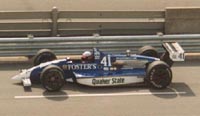 |
Why?
It takes a well-trained eye to identify a 1987 Lola from a ’88 or ’89 version, just like it takes a little effort to identify the March 87C from an 88C. One of the two ’89 March designs (the 89P), however, was a definite stand-alone design, a single car used by one single team during the 1989 season.
A new generation of CART racers due to rule changes introduced for 1990
CART already used the principle of the stepped floor. The lowest point of the sidepod floor had to be at least 2 inch above the monocoque floor. But for 1990, a new rule was introduced. The highest point of the floor of the ground-effect sidepods measured from the lowest point was reduced from 10 inches to 8, making the diffusers shallower. This was done in an attempt to reduce downforce levels and hence cornering speeds. One result was that all of the newly designed cars for the 1990 season received much lower sidepods than was seen in previous years.
It was the start of a trend in which CART cars became lower and appeared to be less bulky. The Lola T90/00 was the first in a line of Lola cars with generally similar lines, a resemblance which lasted long into the nineties. It made the older Lolas and Marches look pretty much outdated. The 1990 Penske also appeared to be lower than the older models.
March had continued the Alfa Romeo project, producing the March 90CA as a result. Though this car looked good from some angles, it was not as slim and low as its rivals. It had design details which looked totally out of place. Even older Lolas appeared to be more aerodynamic behind the cockpit than the March-Alfa did.
The suggested cooperation between the Alfa Romeo and Porsche groups within March must have been minimal. The best example was when the Alfa group ordered rear-wing stands for their car with one company while the Porsche group went for another supplier since the Alfa group had already gone to their first choice!
To add even more amazement about what was going on at March at that time: at the Marchives website (a site entirely devoted to March cars) photographic evidence can be found of even a third different type of Indycar built for 1990, the eventually stillborn 90C. There are all kind of comments possible on that discovery, but let’s not go there at this moment.
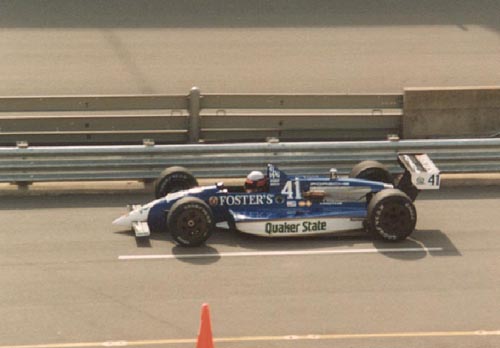
'The Pancake' was elegant in profile. Here John Andretti on a practice day. (photo HG)
Key element to the new trend of lowering the cars was the turbocharger. CART permitted the use of a single turbocharger without an intercooler. The blower, mounted above the gearbox and/or the spacer had always been tucked in right behind the engine. Lola came with a new suggestion in its 1990 design. The turbo was mounted within the spacer between engine and gearbox. Other than a weight advantage (lower GC) it enabled the designers to create lower engine covers. March did not follow this trend with the Alfa-powered 90CA, which had its turbo exhaust much higher up than the Lola.
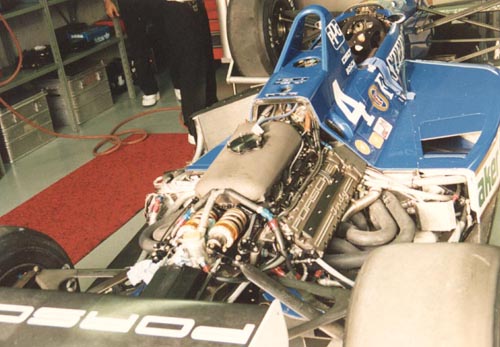
Top view from right rear. (photo HG)
For the Porsche project, March came up with another solution for the turbo. As a result, they created what can be considered the last ever oddball car ever to run at Indianapolis: the March-Porsche 90P.
The Pancake and its recipe
After the successful 1989 season, March and Porsche had plans to improve on chassis technology. However, CART had forbidden the use of full carbon fibre monocoques. The inner part of the 'coques could be carbon fibre but the outer part had to be aluminium. For 1991 full carbon 'coques would be permitted. If asked permission (and such permission was granted) constructors could build such monocoques already for the 1990 season.
March had recent expertise with all-carbon monocoques courtesy of their March-Leyton House Formula One project. So it wasn't that strange that March sought permission for one of their 1990 CART challengers to be built entirely from carbon fibre.
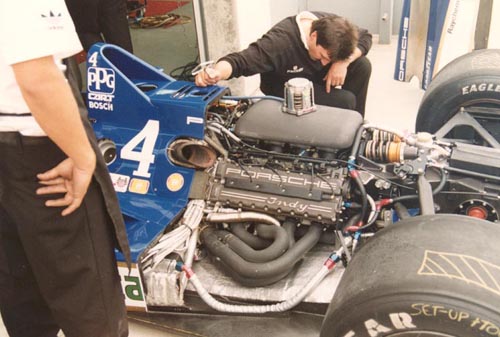
Bodywork taken off, left side view. (photo HG)
Permission was duly granted and the design on a truly revolutionary project began. A major aim of the new car was to make it lower and smaller in order to compensate for the loss of downforce due to the new rules regarding the sidepod floors. But Porsche also enlarged their team with a second entry. Their driver of choice became John Andretti. A young upcoming star who had the additional benefit of being as little as regular Porsche CART driver Teo Fabi. With two such small jockeys within the stable it allowed designers Gordon Coppuck and Tino Belli to design a car that was almost unsuitable for any other driver apart from those two small men. The cockpit size could be made very small and low with only Teo or John to accommodate. As a result, the car became even lower than the Lola, enhancing the smooth airflow to the rear wing quite a bit.
To improve rear-wing efficiency and weight distribution, the gear cluster of the gearbox, normally located behind the rear axle, was relocated between the engine and the rear axle. But that created a problem. What to do with that big 'hairdryer' that breathed life into the V8?
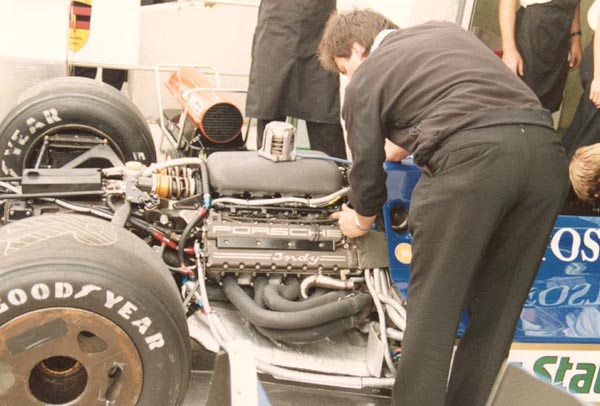
Bodywork taken off, right side view. The dark hole above the yellow decal (between the arm and body of the mechanic) is the air inlet into the turbocharger. (photo HG)
The turbocharger eventually found a place unheard of in a single-seater racing car. It sat between the monocoque and the engine, in the middle of the car! The design of the monocoque incorporated a large indent at the back end, as if a chunk had been taken out. This hole, clothed with heat-shielding material, became the location for the turbo.
The forward part of the 'coque was as narrow as possible but from the driver's hip level to the rear end of the tub it widened into a triangle shape. The end of the 'coque was wider than it was at hip level. These sidesteps were integrated within the sidepods. In cross section these 'coque sidesteps also shaded the exhaust systems located within the sidepod. The Lola T90/00 also had such monocoque sidesteps but these were less prominent as the ones on the March 90P. Generally, the fuel tank parts within the monocoques of CART cars were mostly flat pieces of sheetwork. Not on the March 90P.
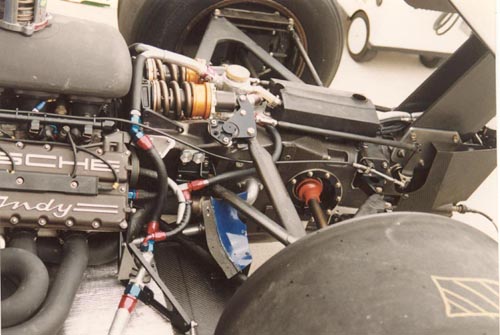
Suspension and gearbox lay-out. The anti-rollbar is at the very end of the gearbox, the pushrods clearly visible.
(photo HG)
Main benefits of these monocoque sidesteps was the capacity to store fuel, thus lowering the height of the required fuel tank and consequently lowering the center part of the car with cockpit and engine cover even more, in addition to an even lower GC. One could also say that the sidestep fuel capacity made up for the space within the monocoque that was lost to fuel storage due to the turbo being located there.
There were more complications because of the turbo sitting in the middle of the car. The exhaust was located in the centre of the car on the left side. The bodywork over the engine, however, had to be shielded from the heat with an aluminium plate. To refuel the car the crew had to use protective shields to keep the fuel away from the blazing hot exhaust pipe.
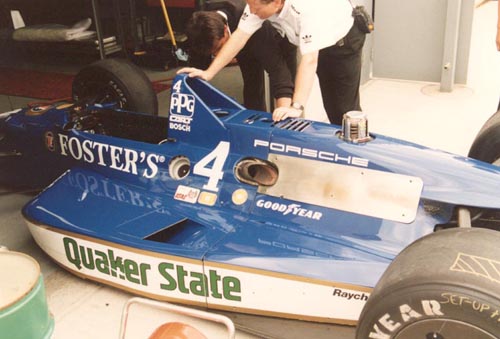
An aluminium plate protected the bodywork against exhaust heat. Look closely to the paintwork behind the aluminium plate and you will understand the need for this plate. The exhaust pipe itself was detachable and taken off here. The blue little piece underneath the upper suspension triangle was part of the upper surface of the sidepod. (photo HG)
The inlet to the turbo was located on the right side of the car, between the fuel tank and the engine. A simple hole within the bodywork gave entry to fresh air. There was no periscope or NACA duct or anything like that directing the air into the intake. Since the turbocharger sat in front of the engine, the oil tank had to be relocated behind the engine.
Another striking detail on the car was the near needlepoint nosecone. Combined with the very low sidepods the car gave the appearance of a jet fighter.
With no turbo behind the engine, the bodywork behind the engine could be kept very low, enhancing the efficiency of the rear wing even further. This bodywork also covered the shock absorbers. To maximise the size of the venturi tunnels and with no turbocharger complicating the lay-out, the shocks lay on top of the gearbox instead of alongside it. The suspension itself was still a push-rod construction.
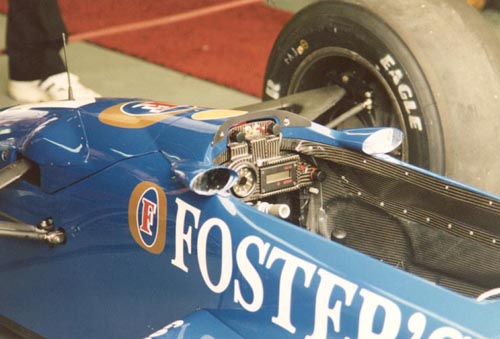
Cockpit of the 90P, see how tiny the rear-view mirrors are! (photo HG)
No other car looked as low and flat as the March-Porsche 90P. Even the protective roll-over hoop barely topped the highest point of the rear wing of the car in Superspeedway trim. When it was installed the high-downforce rear became the highest part of the car.
Maybe the nickname “flounder” would have been appropriate but that name had already been handed out to another Porsche (the 1969 908/2 Spyder). The 90P got a different nickname: the Pancake. (Perhaps inspired by the P in the type designation?)
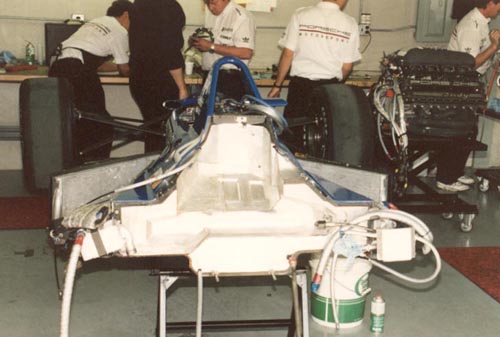
Backside of the monocoque without the engine installed. The monocoque side extensions accommodated fuel, the raised side parts are a result of the ground-effect sidepods which had to be at least 2 inches above the bottom plate of the center part of the monocoque (stepped floor principle). (photo HG)
Apart from being low, the car was also designed to run with the lowest amount of ground clearance possible. This to lower the GC as much as possible as well as to have the sidepod generate maximum amounts of downforce. The pods were the most efficient when the car ran as close to the track surface as possible. No other car rode and raced as low that year as the March-Porsche 90P.
Whether the radical approach to locating parts within the package would be a success remained to be seen but it was certain that this car was the most innovative among the 1990 cars. It would also be one of the ill-fated designs of 1990, and a bunch of complications were at fault.
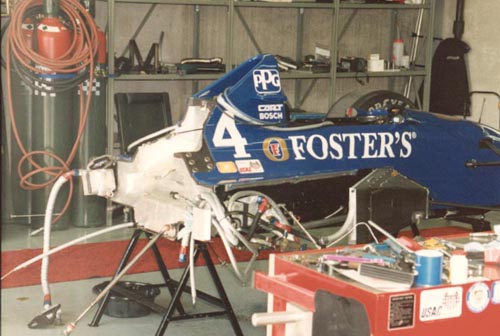
The same tub seen from the right side. (photo HG)
